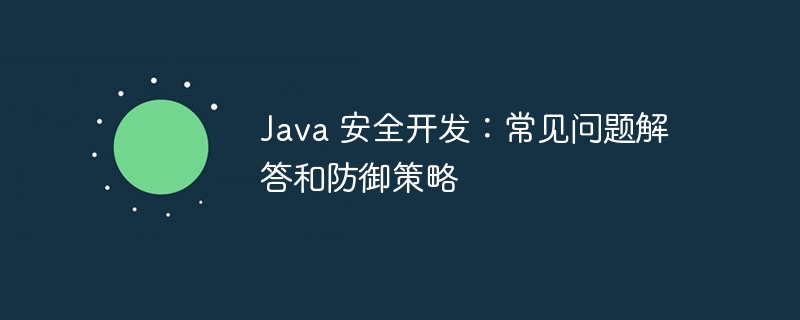
Java security vulnerabilities are flaws in Java programs that allow an attacker to compromise an application or steal sensitive data. The most common vulnerabilities include SQL injection, cross-site scripting, and buffer overflows. Vulnerabilities can be detected through code reviews, static analysis tools, and dynamic testing tools. Defense strategies include encoding input, validating input, using security frameworks, limiting file uploads, and avoiding deserialization. For example, to prevent cross-site scripting, you can use the HtmlEscape function to escape HTML characters in user-submitted data.

Secure Java Development: FAQs and Defense Strategies
FAQs
Question 1: What is a Java security vulnerability?
Answer: A Java security vulnerability is a flaw in a Java program or library that allows an attacker to compromise the application or access sensitive data.
Question 2: What are the most common Java security vulnerabilities?
Answer: Some of the most common Java security vulnerabilities include:
Question 3: How to detect Java security vulnerabilities?
Answer: You can use the following methods to detect Java security vulnerabilities:
Defense Strategies
Strategy 1: Encoded Input
Code example:
String input = request.getParameter("name");
String escapedInput = URLEncoder.encode(input, "UTF-8");Strategy 2: Validate input
Code example:
String input = request.getParameter("age");
int age = Integer.parseInt(input);
if (age < 0 || age > 150) {
throw new IllegalArgumentException("Invalid age: " + input);
}Strategy 3: Use security framework
Code example:
import org.apache.commons.validator.routines.EmailValidator;
// ...
String email = request.getParameter("email");
if (!EmailValidator.getInstance().isValid(email)) {
throw new IllegalArgumentException("Invalid email: " + email);
}Strategy 4: Limit file uploads
Code example:
import java.nio.file.Paths;
// ...
String uploadPath = request.getParameter("uploadPath");
if (!Paths.get(uploadPath).toAbsolutePath().startsWith(Paths.get(baseUploadPath).toAbsolutePath())) {
throw new IllegalArgumentException("Invalid upload path: " + uploadPath);
}Strategy 5: Avoid deserialization
Code example:
// ...
Object obj = request.getAttribute("object");
if (obj instanceof Serializable) {
throw new IllegalArgumentException("Deserialization is not allowed");
}Live Case
Case: Preventing Cross-Site Scripting (XSS)
Question: User Submitted The data contained malicious script code, leading to cross-site scripting (XSS) attacks.
Solution: Use the HtmlEscape utility function to escape HTML characters from user-submitted data.
Code example:
String escapedData = HtmlEscape.escapeHtml(data); // ...
The above is the detailed content of Secure Development with Java: FAQs and Defense Strategies. For more information, please follow other related articles on the PHP Chinese website!
